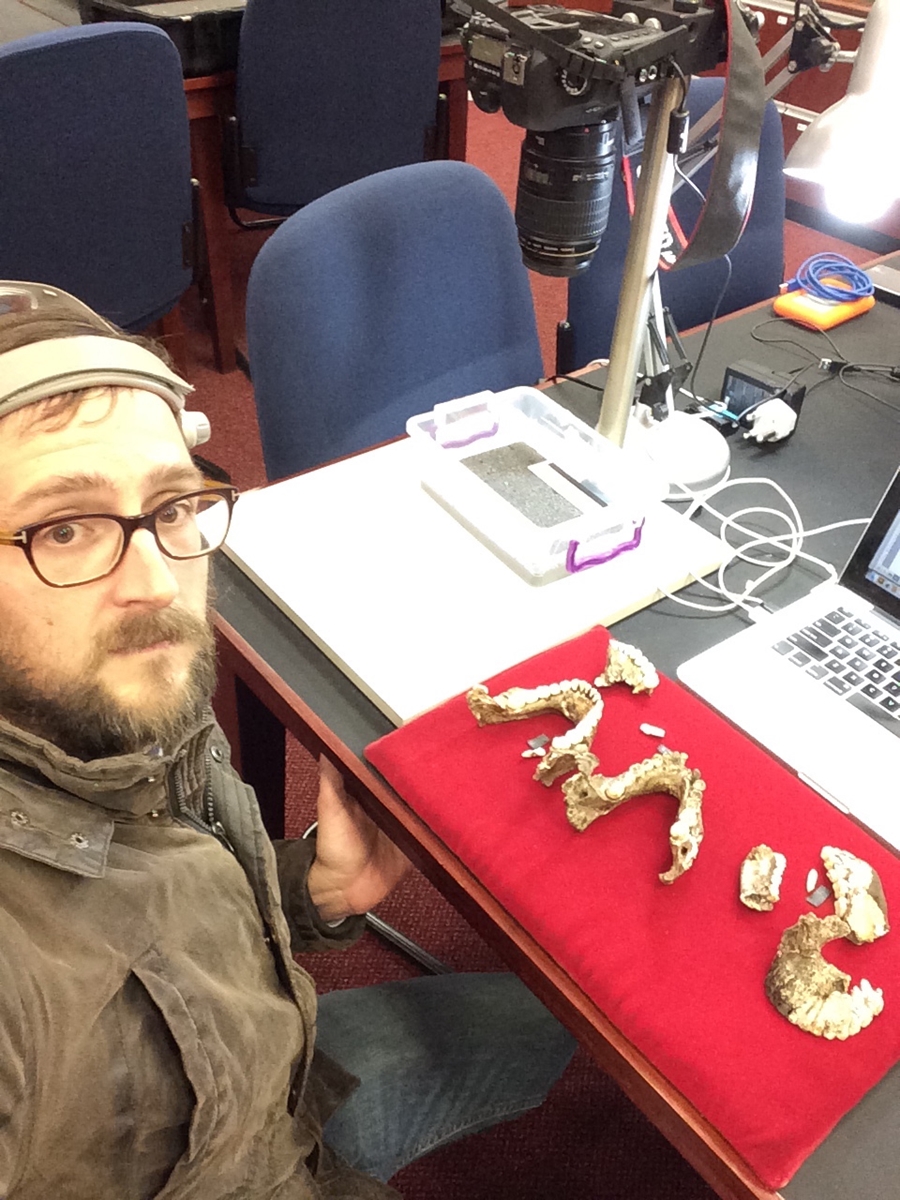New Analysis Finds the Ancient World Populated by Diverse Hominin Species
FAYETTEVILLE, Ark. — New analysis of fossils from a recently discovered human ancestor, Homo naledi, reveals that it evolved parallel to Homo sapiens in South Africa, a finding that potentially redraws the human family tree.
Luke Delezene, assistant professor of anthropology in the J. William Fulbright College of Arts and Sciences at the University of Arkansas, has been a key part of the international research team studying Homo naledi since the fossils were found in the Rising Star Cave in 2013 near Johannesburg, South Africa. An expert in hominin dental anatomy and morphology, Delezene helped verify in 2015 that the remains were a previously unknown hominin.
The latest analysis, published this month in eLife, was the result of work done last summer on the Homo naledi remains found in a second chamber of the cave. The remains were deposited in the cave between 236,000 and 335,000 years ago, much later than researchers expected, indicating they lived in South Africa around the same time as Homo sapiens and Neanderthals roamed the Earth.
“Three years ago this species was totally unknown,” Delezene said. “And now naledi fossils outnumber those of other species of Homo in South Africa. Now, with two large samples of Homo naledi teeth that are practically identical anatomically, we can start to tell the story about how Homo naledi and Homo sapiens evolved in South Africa.”
Homo naledi has an exceptionally small brain — less than half the size of a modern human — a short stature and curved fingers. These features are common in hominins before 2 million years ago. Previously, it was commonly believed that no small-brained hominin species could have survived this late against the intensifying competition from larger-brained humans, with their advanced social and technological behaviors. This discovery indicates that diverse hominins populated the world through much of the last half million years, from small-brained and small-bodied species like Homo naledi to those like modern humans and Neanderthals, who had much larger brains and bodies.
Where Homo naledi belongs on the human family tree, however, is currently debated. Delezene points to its unique mix of modern and primitive anatomical traits – fairly modern wrists and elongated legs and primitive traits like small brains and large wisdom teeth.
“Homo naledi teeth are not like those of living humans; neither are they like the teeth seen in the earliest species of Homo that are nearly 2 million years old,” Delezene said. “The shape of their premolars and molars are quite different from all other hominins, which suggests they adapted to a different dietary regime than other species of Homo, including us.”
Others at the U of A will be looking at the microwear on the teeth to get a better idea of what they did eat. “We have a tremendous opportunity, with these teeth, to tell the story of Homo naledi, but it’s going to take time,” Delezene said.
The team has divided the analysis by anatomical structure, and plans to “write articles as quickly as we can.” The biggest challenge, Delezene said, is that “we have so much material coming out of the ground so fast, we have trouble keeping up.”
The new discovery and research was done by a large team of researchers from the United States, South Africa, Australia, Europe and more than 30 international institutions.
About the University of Arkansas: The University of Arkansas provides an internationally competitive education for undergraduate and graduate students in more than 200 academic programs. The university contributes new knowledge, economic development, basic and applied research, and creative activity while also providing service to academic and professional disciplines. The Carnegie Foundation classifies the University of Arkansas among only 2 percent of universities in America that have the highest level of research activity. U.S. News & World Report ranks the University of Arkansas among its top American public research universities. Founded in 1871, the University of Arkansas comprises 10 colleges and schools and maintains a low student-to-faculty ratio that promotes personal attention and close mentoring.
Topics
Contacts
Luke Delezene, assistant professor of anthropology
J. William Fulbright College of Arts and Sciences
479-575-5570,
delezene@uark.edu
DeLani Bartlett, writer
University Relations
479-575-5709,
drbartl@uark.edu
Headlines
Affairs of the Heart
Find out how biomedical engineering professor Morten Jensen is developing innovative devices to produce better outcomes in cardiovascular medicine.
Students, Faculty and Alumni Kick Off Centennial Year of School of Law
Founded April 14, 1924, the School of Law faculty, students and alumni started the celebration of its centennial year with a Founders Day event and will continue with more commemorative events this coming fall.
Yearly Academic Award Winners, Ambassadors Recognized by Bumpers College
Schyler Angell, Lexi Dilbeck, Cason Frisby, Tanner Austin King, Anna Brooke Mathis, Carrie Ortel, Lucy Scholma, Kadence Trosper and student ambassadors were honored at the college's annual reception.
World Premiere of 'Cries from the Cotton Field' Slated for May 8
Cries from the Cotton Field chronicles the journey of 19th century Italian immigrants from northern Italy to the Arkansas Delta and ultimately to Tontitown. It will premier at 6 p.m. May 8 in Springdale Har-Ber High School.
Fay Jones School's Earth Day Event Spotlights Sustainable Materials and Projects
"One day doesn't seem like a lot, but one day can empower individuals and groups, energize them to work for change and innovate for transformative solutions," professor Jennifer Webb said of the students' design work.





